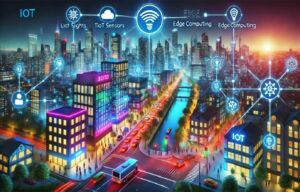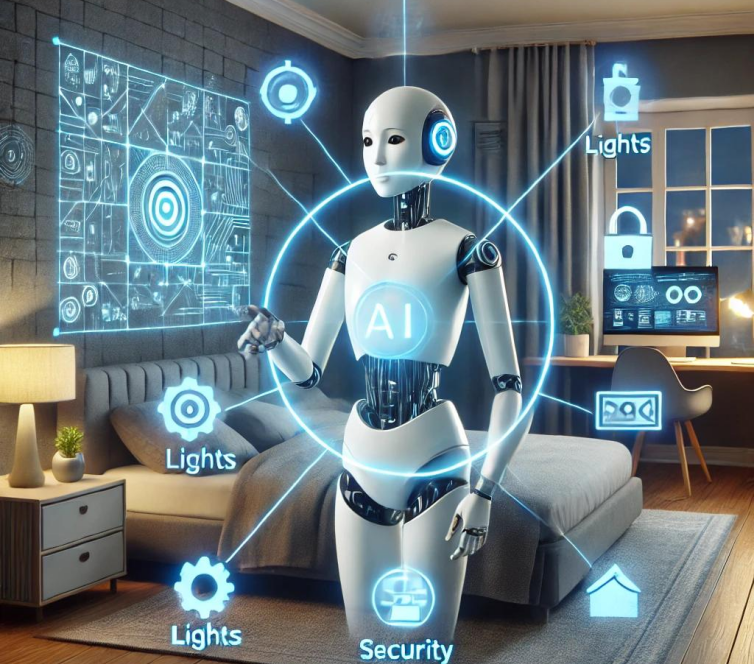Introduction
The Internet of Things (IoT) has revolutionized the way we interact with the world around us. From smart homes to industrial automation, IoT devices are everywhere, collecting data and making our lives more efficient. However, as the number of connected devices grows exponentially,
traditional cloud-based systems are struggling to keep up with the demand for real-time processing. This is where Edge Computing steps in—a game- changing technology that brings computation closer to the source of data.
In this blog, we’ll explore:
- What IoT and Edge Computing are.
- Why Edge Computing is essential for IoT.
- Real-world applications of IoT and Edge Computing.
- Challenges and the future of this powerful combination.
What is IoT?
- The Internet of Things refers to a network of physical devices—ranging from smartphones and smartwatches to industrial sensors and autonomous vehicles—that are embedded with sensors, software, and connectivity to exchange data over the internet. These devices generate massive amounts of data, enabling smarter decision-making and automation.
For example:
- Smart Homes : Devices like thermostats, lights, and security cameras can be controlled remotely via apps.
- Healthcare : Wearable devices monitor heart rate, sleep patterns, and other health metrics.
- Agriculture : Sensors track soil moisture, weather conditions, and crop health to optimize farming practices.
While IoT has immense potential, its reliance on centralized cloud servers for data processing poses challenges, especially when it comes to latency and bandwidth.
What is Edge Computing?
Edge Computing is a distributed computing paradigm that brings data processing closer to the source of data generation—in other words, “at the edge” of the network. Instead of sending all data to a remote cloud server, edge devices process the data locally or in nearby edge servers.
- Why is Edge Computing Important for IoT?
- Reduced Latency : Processing data locally ensures faster response times, which is critical for applications like autonomous vehicles and industrial automation.
- Bandwidth Efficiency : Transmitting only relevant data to the cloud reduces the strain on network bandwidth.
- Improved Security : Sensitive data can be processed locally, minimizing exposure to cyber threats during transmission.
- Offline Functionality : Edge devices can continue functioning even without an internet connection.

Real-World Applications of IoT and Edge Computing
Here are some exciting examples of how IoT and Edge Computing are transforming industries:
1. Smart Cities
- Traffic management systems use IoT sensors to monitor congestion and adjust traffic signals in real time using edge computing.
- Smart streetlights dim or brighten based on pedestrian activity, saving energy.
2. Healthcare
- Wearable devices equipped with edge capabilities can analyze vital signs instantly and alert users or doctors in case of abnormalities.
- Remote patient monitoring systems reduce the need for frequent hospital visits.
3. Manufacturing
- Predictive maintenance uses IoT sensors to detect equipment failures before they occur. Edge computing processes the sensor data on-site, ensuring minimal downtime.
- Quality control systems analyze product defects in real time on the production line.
4. Retail
- Smart shelves in stores use IoT sensors to track inventory levels and automatically reorder stock when needed.
- Augmented reality (AR) mirrors in fitting rooms provide personalized recommendations by analyzing customer preferences at the edge.
5. Autonomous Vehicles
- Self-driving cars rely on IoT sensors (cameras, LiDAR, radar) to perceive their surroundings. Edge computing processes this data locally to make split-second driving decisions.
Challenges in IoT and Edge Computing
While the combination of IoT and Edge Computing offers numerous benefits, there are still hurdles to overcome:
- Scalability : Managing millions of edge devices across diverse environments can be complex.
- Security Risks : Edge devices are often less secure than centralized servers, making them vulnerable to attacks.
- Interoperability : Ensuring seamless communication between different IoT devices and platforms remains a challenge.
- Cost : Deploying edge infrastructure requires significant investment, especially for small businesses.
The Future of IoT and Edge Computing
As 5G networks become more widespread, the synergy between IoT and Edge Computing will only grow stronger. Here’s what the future holds:
- AI at the Edge : Integrating AI models directly into edge devices for smarter, autonomous decision-making.
- Federated Learning : Training machine learning models across multiple edge devices while keeping data localized.
- Sustainability : Edge Computing reduces the carbon footprint associated with transmitting and storing large volumes of data in the cloud.
- Mass Adoption : From smart homes to smart cities, IoT and Edge Computing will become integral parts of daily life.
Conclusion
The fusion of IoT and Edge Computing is paving the way for a smarter, faster, and more efficient future. By processing data closer to its source, we can unlock new possibilities in industries ranging from healthcare to transportation. However, addressing challenges like security and scalability will be key to realizing the full potential of this powerful duo.
As technology continues to evolve, staying informed about innovations in IoT and Edge Computing will not only help you stay ahead but also
inspire creative solutions to real-world problems. So whether you’re building a smart home or designing the next big industrial IoT solution, remember: the edge is where the action is!




